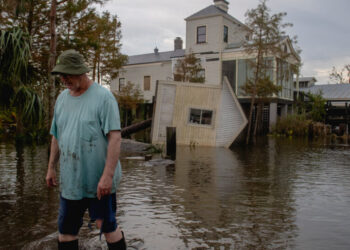On the 11th floor of a downtown Manhattan building, just around the corner from the Holland Tunnel, sits one of the world’s finest collections of coins. Stored behind a series of locked doors in a massive, climate-controlled vault, the coins tell the story of civilization, from antiquity to today.
A Sumerian clay tablet from about 2000 B.C.E. Early Chinese forms of money shaped like miniature tools. A silver French penny from the age of Charlemagne. A medal given by the Lincoln administration to a Native American chief, pierced by a bullet. More than 800,000 other telltale coins, medals and objects of wonder.
But apart from scholars, members and the occasional enthusiast, almost no one sees this treasure, which is one reason its guardian, the American Numismatic Society, is leaving the city where it was founded in the mid-19th century — and moving to Toledo, Ohio.
The society announced today that it will be making a “strategic” relocation to an Art Deco building on the spacious campus of the Toledo Museum of Art. The $20 million plan, to be completed in 2028, would make possible its long-harbored vision of a state-of-the-art money museum, a dream that has proved elusive in New York.
“One of our members said that this will mean a terrible loss to New York City,” the society’s executive director, Ute Wartenberg Kagan, said. “But if no one uses it, what’s the loss?”
Wartenberg Kagan, a scholar of ancient Greek coinage, left the British Museum in 1998 to join the American Numismatic Society and someday establish a proper money museum where one belonged, in the city of Wall Street. But exorbitant costs and space constraints conspired against those plans, as did an apparent indifference to the charms of numismatics.
So: Hello, Toledo!
Wartenberg Kagan said that she and several other colleagues are eager to make the 560-mile move west, where the society has already bought the building that will house its collection as well as a library, auditorium and education center. The population of the Toledo metropolitan area is about 650,000, less than one-tenth that of New York City, but there are many buts.
The cost of living is lower. The campus has plenty of space to accommodate the school buses that never pulled up to the current location because there was nowhere to park. And there is the opportunity to work in concert with the museum, integrating collections to produce dynamic exhibits for an engaged community.
“We’re not just buying real estate,” Wartenberg Kagan said. “We’re buying a relationship.”
But as one relationship begins, another ends. The American Numismatic Society traces its origins to 1858, when a teenage boy named Augustus B. Sage invited other coin obsessives to his family’s Manhattan home to discuss the creation of a society dedicated to all matters numismatic. Sage, who would go on to serve in the Civil War and die young, of pneumonia, donated the first object: an 1825 American half-cent.
In 1908, the society built a neoclassical building at 155th Street and Broadway, in the city’s Washington Heights section, to accommodate its growing membership, library and collection. The numismatic cognoscenti gathered there for lectures and exhibits, for celebrations of National Coin Week and debates about the aesthetics of the buffalo nickel.
But as the years passed, fewer people traveled to Upper Manhattan to see and discuss coins. Mentions of the society sometimes appeared in newspaper roundups of out-of-the-way places to visit in Manhattan.
Excitement occasionally paid a call. In 1977, four armed men overpowered two society guards, meticulously taped cloth over display cases to muffle the sound of glass being broken and made off with about 300 rare coins worth as much as $100,000. As they calmly exited the building, the thieves told three impatient visitors at the door that the place was closed.
And in 1989, a heart surgeon and coin collector from California arrived in New York to be honored by the society for his beneficence, only to be arrested — and later convicted — instead. During his occasional visits, the good doctor had been pocketing rarities worth about $1 million: a gold coin of the Roman Emperor Hadrian here, six gold coins of the Visigoths there.
Facing a yawning deficit, the society sold its Washington Heights building and moved to the Wall Street area in 2004, with plans to open a money museum. But the plan never came to fruition.
In 2008 the society moved again, to leased space on the 11th floor of an old building at 75 Varick Street. Over eight hours one late-spring Saturday, its entire collection, cocooned in bubble wrap and packed in more than 400 plastic crates, was transported to the new location as quietly as can be done with a police escort.
Both the appeals and challenges of the society’s current home were evident during a recent tour. An extensive library all but begged the visitor to pause and flip through a book, any book: on heraldry or mythology, shipwrecks or excavation. Then, once past the several locked doors that guard the vault, Wartenberg Kagan and Peter van Alfen, the chief curator, shared with glee just the smallest hint of the society’s immense treasure.
In this sliding drawer, a silver coin from the reign of Alexander the Great, one of many, portraying him in battle in India. And in this drawer, the famous silver denarius, minted to commemorate the murder of Julius Caesar and depicting two daggers and the bust of his assassin, Brutus. Here, a 1787 doubloon made by a New York City goldsmith, and here, a rare 1861 Confederate half dollar, struck in New Orleans.
A year could be lost in the vault of the American Numismatic Society.
But the society’s leased space is too expensive ($1.8 million a year, including taxes), too small to accommodate its ever-growing holdings and not conducive to public engagement. A few years ago, a travel guide included the society among its list of free attractions — open by appointment and closed on weekends — in Lower Manhattan. Even then, only a half-dozen or so tourists might wander in every week.
“This is both a big and a small place,” Wartenberg Kagan said. “That’s one of its problems.”
For the last several years, the society — which has 1,400 members, including 265 outside the United States — has searched for more suitable quarters. Plans to move to the University of Chicago fell apart, as did those to move to the University of Pennsylvania, Long Island City in Queens and a warehouse in Fall River, Mass.
Then came a bit of numismatic serendipity. It just so happened that AdamM. Levine, the president and director of the Toledo Museum of Art, had spent the summer of 2009 at the American Numismatics Society, studying the iconography of Justinian II coinage. He contacted Wartenberg Kagan, whom he knew, and suggested that she consider Toledo, where he just happened to know of a four-story building on the museum’s 37-acre campus that would soon become available.
Levine, who grew up in the Riverdale section of the Bronx, expressed great affection for his native city. But he is now imbued with what he called the “zeal of the convert,” and he vouched for Toledo’s cultural amenities, community spirit and easy, relatively short ride to the Detroit Metropolitan Wayne County Airport.
“I feel very confident that there is life after New York,” Levine said. “And Toledo is made special by being the only place where you can pretty much guarantee that you’ll like the next person you meet.”
A dubious Wartenberg Kagan visited Toledo — and came away persuaded. It checked every box for the society’s trustees, including a supportive, good-sized city, reasonable housing costs and proximity to major research facilities.
Other staff members also made the trip to Toledo and liked what they saw. About half of the 17-member staff will be making the move, including Wartenberg Kagan and van Alfen.
“They will be welcomed with open arms,” Levine predicted. “And they’ll have more visitors in their first year than they’ve had in the last five.”
“Probably 10 years,” Wartenberg Kagan added.
Dan Barry is a longtime reporter and columnist, having written both the “This Land” and “About New York” columns. The author of several books, he writes on myriad topics, including New York City, sports, culture and the nation.
The post After 167 Years in New York, a Priceless Coin Collection Heads to Toledo appeared first on New York Times.




